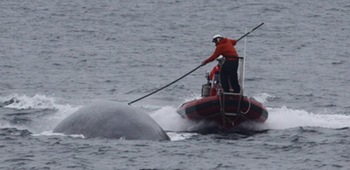 As usual, Brandon Southall is posting regularly from sea as his research team begins the third year of a five year Behavioral Response Study off the coast of southern California. The field work is largely focused on conducting controlled exposure experiments (CEE) on a fairly wide variety of species, in order to learn more about how each species responds to various types of sounds. Animals are approached in zodiacs in order to attach Dtags (temporary suction-cup tags that record sounds heard and produced by the animal, as well as detailed three-dimensional dive patterns) or one of several other types of tags; once the tag has been on long enough for the animal to relax after that tagging approach, a larger ship maneuvers in to position and transmits sequence of test sounds. So far, test sounds have been a simulated mid-frequency active sonar signal (peaking at 25dB quieter than the Navy uses) and a pseudo-random noise stimulus. For background on this year’s study objectives, see the SOCAL-12 informational webpage.
As usual, Brandon Southall is posting regularly from sea as his research team begins the third year of a five year Behavioral Response Study off the coast of southern California. The field work is largely focused on conducting controlled exposure experiments (CEE) on a fairly wide variety of species, in order to learn more about how each species responds to various types of sounds. Animals are approached in zodiacs in order to attach Dtags (temporary suction-cup tags that record sounds heard and produced by the animal, as well as detailed three-dimensional dive patterns) or one of several other types of tags; once the tag has been on long enough for the animal to relax after that tagging approach, a larger ship maneuvers in to position and transmits sequence of test sounds. So far, test sounds have been a simulated mid-frequency active sonar signal (peaking at 25dB quieter than the Navy uses) and a pseudo-random noise stimulus. For background on this year’s study objectives, see the SOCAL-12 informational webpage.
In addition, researchers on the cruise pursue other related studies, including ongoing visual observation surveys, tests of new acoustic monitoring systems, and trials of new research methodologies for monitoring behavior of non-tagged animals for possible future exposure studies. A summary of last year’s field work can be downloaded at the SOCAL-11 website; SOCAL-11 succeeded in attaching 38 tags of four different types on 35 individuals of four different marine mammal species. For the suction cup acoustic/position tags used in SOCAL?11 (not including the satellite tags), this resulted in nearly 200 hours of tag data across these individuals, the majority resulting from Dtag deployments. Thirteen complete CEE sequences were conducted, involving 13 blue whales, 4 Risso’s dolphins, and 1 Cuvier’s beaked whale. Preliminary analysis of dive patterns suggest that blue whales and Risso’s dolphins showed little response to the sounds (though the dolphins were resting at the surface during the CEEs; deep diving behavior has not been taking place during CEE’s so far), while the beaked whale showed “a similar relatively strong response at low received level (ed. note: peak of 135-140dB re 1 uPa, with behavioral response initiated when the signal was not much above background ambient) as was observed in SOCAL-10.”
